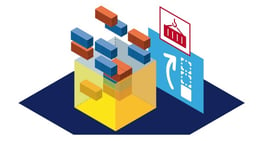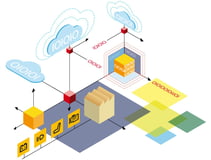Is Your ERP Strategy Industry 4.0-ready?
Brian Hoey - January 16, 2020

Most prognosticators have pretty much agreed that Industry 4.0 is going to radically change the world of manufacturing through big data, cyber-physical systems, and internet of things (IoT) integration—but not everyone agrees on exactly what this new paradigm is really going to look like. This might seem like disagreement, but in reality it’s part of the point: Industry 4.0 is going to look different at different companies. It’s even going to look different during different seasons, or for different production flows. An easy, consistent definition and an easy set of IT expectations is anathema to the whole idea of the fourth industrial revolution.
While this is all exciting from the perspective of increased agility, improved product customization, and smarter manufacturing overall, it does put planners in a difficult spot. How do you optimize your planning flows to allow for last minute plan changes? How do you assess and adopt technology that will meet organizational needs that haven’t even emerged yet? These quandaries are perhaps most pressing when it comes to ERP technology, because these systems are traditionally positioned at the center of any given manufacturer’s strategic planning workflows. So, how can manufacturing outfits determine whether their ERP systems are ready for Industry 4.0 technologies?
ERP Challenges in the Industry 4.0 Era
According to Deloitte, much of the transition to Industry 4.0 will revolve around how we collect, store, and access data, and ERP systems will have to be at the heart of that. This will require a level of flexibility that most ERP software isn’t designed to handle. Anything that follows in the mold of “modern ERP,” with a rigidly centralized IT infrastructure, will pose a risk of failing to integrate with the types of software and hardware that will be transmitting and receiving mission critical production data in the near future. By the same token, a lot of ERP solutions aren’t designed to enable real-time collaboration, which has a tendency to result in information and planning silos. This obviously makes it difficult to create an agile or dynamic planning flow that truly incorporates the massive influx of data from, say, your production floor RFID chips or the IoT sensors in your warehouse.
Another potential challenge here will be the integration of real-time information and capabilities into these systems. Again, this depends in large part on flexibility. Why? Because the system will need to take in live information from numerous sources, including other software solutions designed to optimize more niche elements of the broader corporate planning process. If planners across functions can’t collaborate in real time on a shared vision of resource usage, the data that’s supposed to power faster and smarter supply chain decision making (sometimes even without human intervention) will languish unutilized. No matter how sophisticated the rest of your Industry 4.0 technology is, most decisions will have to pass through the ERP at some point, meaning that it has a real potential to become a bottleneck of epic proportions.
Decentralized Data Management
Given all of the above, to prepare your ERP for Industry 4.0 you need to make decentralized data management a big priority. This means ditching the modern ERP mindset in favor of Postmodern ERP, in which your central ERP system integrates flexibly with your other IT implementations. In this way, the live stream of IoT data from your warehouse will be stored and analyzed within your warehousing team’s unique IT deployment, with finalized inventory plans then making their way into the ERP’s transactional system, for example. In this way, you prevent the rise of data silos that could create operational disconnect.
Again, this is in many ways anathema to the traditional logic of ERP software, which tends to err on the side of centralization. Since decision-making in an Industry 4.0 environment is decentralized by design, your software ecosystem needs to reflect that fact. If, for instance, you have an S&OE planner who’s tasked with adjusting transport routes to daily and weekly changes in demand based on live data, that planner needs the latitude to actually adjust ongoing workflows on the fly. If she can’t do that in a way that complies with the rules in your ERP, she’ll do it in a silo, meaning that longer term S&OP planners will have a skewed snapshot of actual demand levels and transportation workflows. When planning out future resource usage, they’ll inevitably create plans that are rooted in incorrect data, which can put the entire company on a risky course.
Risks and Rewards in Digital Transformation
Now, if you’re reading this article, we’re willing to bet you’re in one of two situations:
- You’re taking stock of your current IT infrastructure to see what needs improvement as you implement Industry 4.0 technologies;
- You’re actively in the midst of your digital transformation and you’re seeking out some applicable criteria for judging potential software solutions.
In either case, you’re going to need to know some of the risks (as well as the expected areas for ROI) that come with any new digitization efforts. We discussed some of the potential risks of a modern ERP approach above—but your ERP also needs to fit into a larger, more digitally-minded corporate strategy. This obviously puts you in a position where choosing the wrong piece of technology or software could have a big impact on your bottom line.
Conversely, adopting the right tools to carry you forward into a new IT landscape can put you at a real competitive advantage. So, how do you know which is the right tool for the job? For starters, you should consider integration: how easy or difficult is it to implement this software into an existing IT environment, and how easy is it to combine the technology with new software later? Beyond that, you need to think about usability: Does the UX of the software you’re considering make life easy for users? Does it have all of the functionality your teams think they’ll need? From there, you can start to drill down the answer to the ultimate question: will your new tool help you to make smarter, more data-driven decisions faster than ever?
If you want to learn more get your Guide to Industry 4.0:
LATEST POSTS
- Understand Why Production Planning Needs Specialized Solutions
- Understand Circular Economy in The Manufacturing Industry
- How Can Industry 4.0 IT Integration Be Achieved Smoothly?
- The Significance of Order Sequencing in Discrete Manufacturing
- How to improve your Supply Chain Management: The Power of Control Towers



